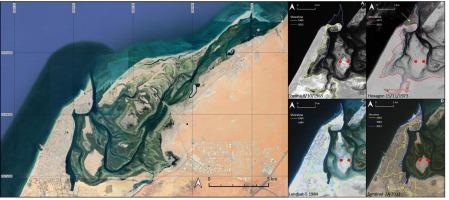乌姆盖万(阿联酋)沿海泻湖系统的地貌演变:自然过程和近期人类影响
IF 5.4
1区 农林科学
Q1 GEOSCIENCES, MULTIDISCIPLINARY
引用次数: 0
摘要
沿海泻湖系统是高度敏感的环境,目前正经受着气候变化和人类压力的影响,这正在引发原始生物多样性和地貌动态的改变。气候和/或构造引起的海平面变化以及与入海口相连的河流的基面和/或流速的变化严重影响着泻湖生态系统的平衡,引发生态变化和/或地貌改变。例如,从红海到波斯湾/阿拉伯湾的阿拉伯半岛海岸线上遍布着正在发生深刻变化的沿岸泻湖。在整个全新世,阿拉伯泻湖经历了由海平面变化、海洋环流变化和末次冰川大化后主 要河流(如底格里斯河和幼发拉底河)排泄量变化引发的随后几个阶段的变化。这些因素重塑了这些地区的地貌,促进了阿拉伯联合酋长国(UAE)沿岸淡水生态系统的演变,并影响了大面积红树林的生长。近年来,人为因素破坏了阿布扎比和哈伊马角之间沿海泻湖系统的原始动态和生态系 统。由于城市扩张,当地泻湖发生了重大变化,包括沿岸填海造地以扩大沿海地区,包括建造人工岛屿,以及随之而来的环流变化和红树林减少。乌姆盖万酋长国(Umm al-Quwain,UAQ)的环礁湖由于城市扩张速度较慢,填海造地工程有限,仍然保留着广阔的红树林生态系统、原始地貌和几乎未受破坏的潮汐动态。因此,这里是进行地貌评估的理想场所,评估采用了多时空遥感(从 1968 年到 2022 年)和实地验证相结合的方法,旨在深入了解潮汐-泻湖和海岸系统及地貌的形成和动态。此外,还对 UAQ 泻湖的特定区域进行了详细的地貌重建,追溯其演变历史,为解释过去人类社区的适应战略和资源开发模式提供信息。本文章由计算机程序翻译,如有差异,请以英文原文为准。

Geomorphological evolution of the Umm al-Quwain (UAE) coastal-lagoon system: Natural processes and recent human impact
Coastal lagoon systems are highly sensitive environments currently experiencing the impact of climate change and human pressure, which are triggering alteration of pristine biodiversity and geomorphic dynamics. Climate- and/or tectonic-induced changes in sea-level and shifts in the base level and/or flow rate of rivers connected to inlets heavily affect the balance of lagoon ecosystems, triggering ecological changes and/or alterations in landforms. For instance, the shorelines of the Arabian Peninsula, stretching from the Red Sea to the Persian/Arabian Gulf, are dotted by coastal lagoons that are undergoing deep transformations. Across the Holocene, Arabian lagoons underwent subsequent phases of modification triggered by sea-level changes, modifications of ocean circulation, and post-Last Glacial Maximum shifts in the discharge of main rivers (e.g., Tigris and Euphrates rivers). These factors reshaped the geomorphology of such contexts, promoting the evolution of freshwater ecosystems along the shorelines of the United Arab Emirates (UAE) and influencing the growth of extensive mangrove forests. In recent years, human agency has disrupted the pristine dynamics and ecosystems of coastal-lagoon systems between Abu Dhabi and Ras al-Khaimah. Local lagoons have undergone significant changes due to urban expansion involving land reclamation initiatives along the coast to expand coastal areas, including the construction of artificial islands and the consequent changes in circulation and reduction of mangrove forests. The lagoon of the Emirate of Umm al-Quwain (UAQ), thanks to the slower rate of urban sprawl and limited land reclamation operations, still preserves an extensive mangrove ecosystem, pristine landforms, and almost unspoilt tidal dynamics. For that reason, it constitutes the ideal context for a geomorphological assessment based on a combined multi-temporal remote sensing (from 1968 to 2022) and field validation approach, aimed at achieving a deep understanding of the formation and dynamics of tidal-lagoon and coastal systems and landforms. Furthermore, a detailed geomorphological reconstruction of specific sectors of the UAQ lagoon traced its evolutionary history, informing interpretations of past human communities’ adaptation strategies and resource exploitation patterns.
求助全文
通过发布文献求助,成功后即可免费获取论文全文。
去求助
来源期刊

Catena
环境科学-地球科学综合
CiteScore
10.50
自引率
9.70%
发文量
816
审稿时长
54 days
期刊介绍:
Catena publishes papers describing original field and laboratory investigations and reviews on geoecology and landscape evolution with emphasis on interdisciplinary aspects of soil science, hydrology and geomorphology. It aims to disseminate new knowledge and foster better understanding of the physical environment, of evolutionary sequences that have resulted in past and current landscapes, and of the natural processes that are likely to determine the fate of our terrestrial environment.
Papers within any one of the above topics are welcome provided they are of sufficiently wide interest and relevance.
 求助内容:
求助内容: 应助结果提醒方式:
应助结果提醒方式:


